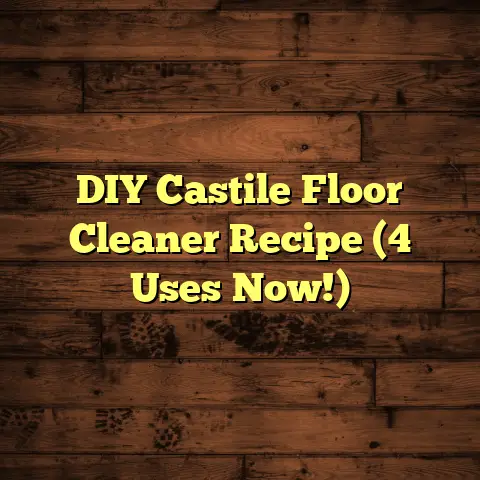Bamboo Flooring: Pros & Cons (5 Myths Busted!)
You know, it seems like everyone’s talking about sustainable living these days, and for good reason!
We all want to make choices that are good for our homes and the planet.
That’s why I’m seeing more and more homeowners turning to eco-friendly materials, and bamboo flooring has definitely emerged as a frontrunner.
It’s renewable, it’s got a unique aesthetic, and it’s often touted as a great alternative to traditional hardwood.
In fact, the global bamboo flooring market is projected to reach \$1.2 billion by 2027, according to a report by Global Market Insights.
That’s a lot of bamboo!
But is it really all it’s cracked up to be?
Well, that’s what we’re here to find out.
We’re going to explore the pros and cons of bamboo flooring, and I’m also going to bust some common myths that I hear all the time.
So, grab a cup of coffee, settle in, and let’s get started!
Section 1: Understanding
Bamboo Flooring
Okay, first things first: What is bamboo flooring, anyway?
Basically, it’s a type of flooring made from bamboo stalks.
Now, before you start picturing giant panda bears munching on your floors, let me explain how it differs from traditional hardwood.
Hardwood, as you probably know, comes from trees like oak, maple, and cherry.
These trees take decades to mature, which makes hardwood a less renewable resource.
Bamboo, on the other hand, is a grass that can grow incredibly quickly.
Some species can grow up to 3 feet in just 24 hours!
That rapid growth rate is what makes bamboo such an appealing sustainable option.
But here’s the thing: not all bamboo flooring is
created equal.
There are several different types,
and each has its own unique characteristics.
Let’s take a look:
Horizontal Bamboo: This is the most
traditional type.
Bamboo strips are laid flat
and glued together, creating a wide-grain
appearance.Vertical Bamboo: In this type, the bamboo
strips are oriented on their edges and glued
together.
This results in a more linear,
contemporary look.Strand-Woven Bamboo: This is the hardest
and most durable type.
Bamboo strands are
shredded, compressed under high pressure, and
then bonded together with adhesives.
I’ve worked with all three types, and I can tell you that strand-woven is definitely the toughest.
It can withstand a lot of wear and tear.
Now, let’s talk about the manufacturing process.
It all starts with sourcing the bamboo.
Ideally, the bamboo should come from sustainably managed forests.
Look for certifications like the Forest Stewardship Council (FSC) to ensure responsible sourcing.
Once the bamboo is harvested, it’s cut into strips, treated to remove sugars (which can attract pests), and then dried.
Then, depending on the type of flooring being made, the strips are either glued together horizontally or vertically, or shredded and woven into strands.
Finally, the flooring is finished with a protective coating.
It’s important to note that the adhesives and finishes used in the manufacturing process can impact the overall sustainability of the flooring.
Look for low-VOC (volatile organic compound) products to minimize off-gassing and promote better indoor air quality.
Section 2: The Pros of
Bamboo Flooring
Alright, now that we’ve got a good understanding of what bamboo flooring is, let’s talk about the good stuff: the pros!
Eco-Friendly Material
We’ve already touched on this, but it’s worth
emphasizing.
Bamboo’s rapid growth rate makes it a
highly renewable resource.
Unlike hardwood trees that take decades to mature, bamboo can be harvested in as little as 3-5 years.
This means that bamboo forests can regenerate quickly, reducing pressure on old-growth forests.
Also, bamboo requires minimal pesticides and fertilizers to grow, which further reduces its environmental impact.
As I mentioned earlier, responsible sourcing is
key.
Look for certifications like FSC to ensure
that the bamboo is being harvested in a sustainable
manner.
These certifications ensure that the forests are being managed in a way that protects biodiversity, water quality, and the rights of local communities.
Aesthetic Versatility
One of the things I love about bamboo flooring is its versatility.
It comes in a wide range of styles, colors, and finishes, so you can find something to match just about any décor.
You can get bamboo flooring that looks like traditional hardwood, or you can opt for a more modern, minimalist look.
The natural color of bamboo is a light, golden hue, but it can be stained to achieve a variety of different shades.
Darker stains can give it a richer, more elegant look, while lighter stains can create a more casual, beachy vibe.
And the grain patterns can vary depending on the type of bamboo flooring you choose.
Horizontal bamboo has a distinctive, knuckle-like grain, while vertical bamboo has a more linear, striped appearance.
Strand-woven bamboo has a unique, almost marbled look.
Compared to other flooring options, bamboo offers a unique blend of natural beauty and contemporary style.
It can add warmth and character to any room, and it can be a great way to bring a touch of nature indoors.
Durability and Strength
Okay, let’s talk about durability.
This is a big one, because nobody wants flooring that’s going to get scratched and dented easily.
The hardness of bamboo flooring is measured using the Janka hardness scale.
This scale measures the force required to embed a steel ball into the wood.
The higher the number, the harder the wood.
Here’s a quick comparison:
As you can see, strand-woven bamboo is actually harder than many traditional hardwoods!
This means that it’s more resistant to wear, scratches, and dents.
I’ve installed strand-woven bamboo in high-traffic areas like kitchens and living rooms, and it holds up really well.
However, it’s important to note that not all bamboo flooring is created equal when it comes to durability.
Horizontal and vertical bamboo are softer than strand-woven, so they may be more prone to scratches and dents.
Also, the quality of the finish can impact the flooring’s resistance to wear.
A good-quality finish will provide a protective layer that helps to prevent scratches and stains.
Bamboo flooring can also perform well in humid environments, but it’s important to choose the right type and take proper precautions.
Strand-woven bamboo is generally more resistant to moisture than horizontal or vertical bamboo.
And it’s always a good idea to use a moisture barrier underlayment when installing bamboo flooring in areas that are prone to dampness.
Easy Maintenance
Another great thing about bamboo flooring is that it’s relatively easy to maintain.
Regular sweeping or vacuuming is all that’s usually needed to keep it clean.
For deeper cleaning, you can use a damp mop with a mild detergent.
Just be sure to avoid using excessive water, as this can damage the flooring.
I always recommend using a pH-neutral cleaner specifically designed for hardwood or bamboo floors.
Avoid using harsh chemicals or abrasive cleaners, as these can strip the finish and damage the flooring.
Compared to other flooring materials like carpet or tile, bamboo flooring requires very little maintenance.
It doesn’t stain easily, and it’s resistant to mold and mildew.
Cost-Effectiveness
Now, let’s talk about money.
How does bamboo flooring stack up in terms of cost?
Well, the price of bamboo flooring can vary depending on the type, quality, and brand.
However, in general, it’s comparable in price to mid-range hardwood flooring.
Here’s a rough cost comparison:
As you can see, bamboo flooring is generally more expensive than laminate or carpet, but it’s often cheaper than hardwood or tile.
But the initial cost is just one factor to consider.
You also need to think about the long-term value proposition.
Bamboo flooring is durable and long-lasting, so you won’t have to replace it as often as you would with cheaper flooring options.
And because it’s easy to maintain, you’ll save money on cleaning and maintenance costs over the long run.
Section 3: The Cons of
Bamboo Flooring
Okay, we’ve covered the good stuff.
Now it’s time to talk about the downsides.
Like any flooring material, bamboo has its limitations.
Susceptibility to Scratches
and Dents
While strand-woven bamboo is quite durable, it’s not impervious to damage.
It can still be scratched or dented by sharp objects or heavy furniture.
Pet claws can also be a problem, especially if you have large dogs with sharp nails.
To minimize the risk of scratches and dents, I recommend using rugs in high-traffic areas and placing felt pads under furniture legs.
You should also trim your pet’s nails regularly.
And if you do get a scratch or dent, you can often repair it with a touch-up kit.
Environmental Concerns
While bamboo is generally considered to be an eco-friendly material, there are some potential environmental concerns to be aware of.
The biggest concern is the impact of bamboo harvesting on ecosystems.
If bamboo forests are not managed sustainably, harvesting can lead to deforestation, soil erosion, and loss of biodiversity.
That’s why it’s so important to choose bamboo flooring that is certified by a reputable organization like the FSC.
Another concern is the use of adhesives and finishes in the manufacturing process.
Some adhesives and finishes contain harmful chemicals that can off-gas into the air.
Look for low-VOC products to minimize this risk.
Moisture Sensitivity
Bamboo flooring is generally more resistant to moisture than hardwood, but it’s not waterproof.
Excessive moisture can cause the flooring to swell, warp, or even rot.
That’s why it’s important to avoid installing bamboo flooring in areas that are prone to dampness, such as bathrooms or basements.
If you do install bamboo flooring in a potentially damp area, be sure to use a moisture barrier underlayment and take steps to prevent water damage.
Wipe up spills immediately, and avoid using excessive water when cleaning the floor.
Limited Resale Value
While bamboo flooring is becoming increasingly popular, it’s still not as widely recognized as hardwood or tile.
This means that it may not add as much value to your home when you sell it.
Some potential buyers may be unfamiliar with bamboo flooring, or they may have misconceptions about its durability or appearance.
However, this is changing as bamboo flooring becomes more mainstream.
And if you choose a high-quality bamboo flooring that is well-maintained, it can definitely be a selling point for your home.
Perception and Misunderstanding
One of the biggest challenges facing bamboo flooring is perception.
Many homeowners still have misconceptions about bamboo’s durability, appearance, or sustainability.
Some people think that bamboo flooring is cheap and flimsy, while others think that it’s only suitable for certain styles.
These misconceptions can deter homeowners from considering bamboo flooring, even though it may be a great option for their needs.
That’s why it’s so important to educate yourself about bamboo flooring and to separate fact from fiction.
Section 4: Busting 5 Common
Myths About Bamboo Flooring
Okay, let’s tackle some of these common myths head-on!
Myth 1: Bamboo Flooring is
Just Like Hardwood Flooring
This is a common misconception.
While bamboo flooring can look similar to hardwood, it’s actually quite different.
The main difference is that bamboo is a grass, while hardwood is a wood.
This means that bamboo has a different cellular structure than hardwood, which affects its durability, moisture resistance, and overall performance.
Also, bamboo is a much more renewable resource than hardwood.
Myth 2: Bamboo Flooring
is Not Durable
This is simply not true, especially when it comes to strand-woven bamboo.
As we discussed earlier, strand-woven bamboo is actually harder than many traditional hardwoods.
It can withstand a lot of wear and tear, and it’s resistant to scratches and dents.
Of course, not all bamboo flooring is created equal.
Horizontal and vertical bamboo are softer than strand-woven, so they may be more prone to damage.
But a good-quality strand-woven bamboo flooring can be just as durable as a hardwood floor.
Myth 3: All Bamboo Flooring
is Sustainable
Unfortunately, this is not the case.
While bamboo is generally considered to be a sustainable material, not all bamboo flooring is created equal.
Some manufacturers use unsustainable harvesting practices, or they use adhesives and finishes that contain harmful chemicals.
That’s why it’s so important to choose bamboo flooring that is certified by a reputable organization like the FSC.
This ensures that the bamboo is being harvested in a sustainable manner and that the flooring is made with low-VOC materials.
Myth 4: Bamboo Flooring is
Only Suitable for Certain Styles
This is another misconception.
Bamboo flooring is incredibly versatile, and it can fit into just about any interior aesthetic.
You can get bamboo flooring in a wide range of styles, colors, and finishes, from traditional to contemporary.
It can be stained to match any décor, and it can be used in just about any room in the house.
Myth 5: Bamboo Flooring
is Expensive
While bamboo flooring is not the cheapest flooring option, it’s not necessarily expensive either.
As we discussed earlier, it’s comparable in price to mid-range hardwood flooring.
And when you consider its durability, sustainability, and ease of maintenance, it can actually be a very cost-effective option over the long run.
Conclusion: Summarizing Insights
So, there you have it!
A comprehensive look at the pros and cons of bamboo flooring.
As you can see, there are many benefits to choosing bamboo flooring, including its sustainability, aesthetic versatility, durability, and cost-effectiveness.
However, there are also some potential drawbacks to be aware of, such as its susceptibility to scratches and dents, potential environmental concerns, and moisture sensitivity.
Ultimately, the decision of whether or not to choose bamboo flooring is a personal one.
You need to weigh the benefits against the drawbacks and consider your own needs and preferences.
But I hope that this article has helped you to make a more informed decision.
Call to Action
Now, I want to hear from you!
Have you had any experience with bamboo flooring?
What are your thoughts on its pros and cons?
Share your thoughts and experiences in the comments below!
I’m always happy to hear from my readers.
And if you found this article helpful, please share it with your friends on social media.
Thanks for reading, and happy renovating!





